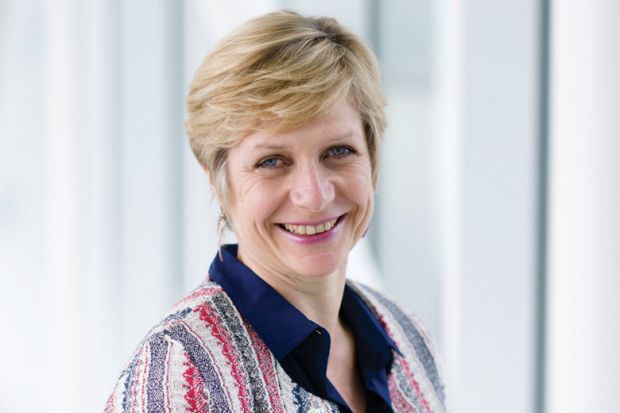Describe your career so far.
I was born and brought up in the UK, and have been working at the University of Cadiz in Spain as a lecturer since 1988. In 1999, I took on the role of director of European programmes at Cadiz, and went on to head the international office and the international promotion department. At a national level, I chaired Spain’s Commission for International Promotion from 2008 until 2010, created by the Spanish Rectors’ Conference. I was also a member of the initial advisory committee to the Universidad.es Foundation, a public sector foundation for the international promotion of Spanish universities. Alongside my involvement in the European Association for International Education, I was a member of the executive committee of the Compostela Group of Universities from 1999 to 2007 and then served as vice-president from 2007 to 2015.
How did you get involved with the EAIE?
I had already attended several EAIE conferences when a respected friend and colleague, Michael Cooper, who knew of my work and contacts in Latin America, suggested that I stand for election to the steering group of the EAIE expert community, now known as Cooperation for Development. That was in 2006 and from there I went on to sit on the Publications Committee, the General Council, and then was elected vice-president. Once you get involved, it’s hard to stop – working with such a committed group of individuals draws you in.
Why is international education important?
I believe we can quite comfortably say that internationalisation of higher education is inherently a good thing. There is a clear consensus, shown through surveys carried out by the International Association of Universities, the European University Association and the EAIE Barometer, that the main benefits of internationalisation are improvement in the quality of teaching and learning, and preparing students to live and work in a globalised world.
Did you have international experience as a student?
In my university days, the Erasmus programme hadn’t yet started, but I was fortunate enough to study a degree that required us to spend a year abroad. I studied modern languages (translating and interpreting) at Heriot-Watt University in the UK and spent a semester each at the universities of Mons, in Belgium, and Salamanca, in Spain. That year changed my life.
Why are some nations and individuals more enthusiastic about internationalisation than others?
I’m not sure it’s so much a question of enthusiasm as a response to the role that internationalisation is seen to play. For some, its main purpose is revenue generation, while for others it may be seen as part of a longer-term strategy, or a contribution to the technological and economic development of the country. Either way, we should remember that it is not an end in itself but a means to improve quality and enhance the role of higher education as a service to society.
What is the biggest barrier to internationalisation?
As in many other aspects of life, insufficient funding is always a major barrier – to national, institutional and individual ambitions.
How integral is transnational education to internationalisation?
It is just one of the options available as part of an internationalisation strategy, be it on a national, regional or institutional level. The UK has a strong TNE tradition, which looks set to grow in the coming years, while other countries engage in a much more limited way. Many factors are at play here, such as market demand, legal limitations and resources available; TNE does not necessarily suit everyone.
Has the digital revolution rendered foreign franchises and branch campuses obsolete?
In my view, the digital revolution has, to date, provided higher education with the means to do more and to support and enhance many of our activities. It does not, however, replace them, and that includes TNE.
Do you feel that rising concerns in the West about immigration could have a negative effect on international education?
It would, I think, be naive to pretend otherwise. And so we, as international educators, have to work that much harder to make it clear that education is the key to integration, intercultural understanding and prosperity for all.
What is your biggest regret about the current state of internationalisation?
I think there is still a long way to go for internationalisation to achieve its full potential – in terms of both equity of access and ensuring that international partnerships are based on respect, fairness and shared benefits. The commercialisation of internationalisation, as well as the growth of competition rather than cooperation, are concerns felt by many.
Should the balance of students on each university campus reflect overall global populations?
The key word here is diversity, but that doesn’t mean simply mirroring global populations. Balancing student mobility flows is important, but so is balancing the diversity of the student population and ensuring opportunities for all. This includes making international opportunities available for those with limited incomes, for instance, or those with disabilities or from minority groups. Diversity is about much more than just nationality.
Is internationalisation compatible with combating global warming?
That’s an interesting point, and one we’ve recently been discussing in the EAIE. We are aware, for example, that the 5,000-plus people travelling to our conference create a huge carbon footprint. We’re looking into ways to compensate for that, such as contributing to tree-planting schemes and investing in technology that will allow us to make greater use of virtual meetings throughout the year.
What is the one action or policy change that would do the most to promote internationalisation?
Facilitating visas and ensuring a fair and equal treatment of international students would go a long way. But we shouldn’t forget the non-mobile majority and we must ensure that we provide an international dimension to the formal and informal curriculum so that all students can develop international and intercultural competences. That would be a tremendous leap forward for internationalisation.
Register to continue
Why register?
- Registration is free and only takes a moment
- Once registered, you can read 3 articles a month
- Sign up for our newsletter
Subscribe
Or subscribe for unlimited access to:
- Unlimited access to news, views, insights & reviews
- Digital editions
- Digital access to THE’s university and college rankings analysis
Already registered or a current subscriber?




